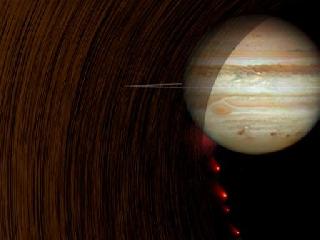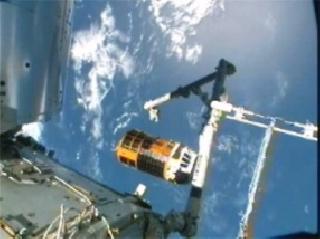
This artist's concept shows comet Shoemaker-Levy 9 heading into Jupiter in July 1994. Photo by M. Showalter
PASADENA, CALIFORNIA (BNS): Scientists working with data from NASA's Cassini, Galileo and New Horizons missions have traced telltale ripples in the rings of Saturn and Jupiter back to collisions with cometary fragments dating back more than ten years ago.
The ripple-producing culprit, in the case of Jupiter, was comet Shoemaker-Levy 9, whose debris cloud hurtled through the thin Jupiter ring system during a kamikaze course into the planet in July 1994.
Scientists attribute Saturn's ripples to a similar object – likely another cloud of comet debris -- plunging through the inner rings in the second half of 1983. The findings are detailed in a pair of papers published online in the journal Science.
From Galileo's visit to Jupiter, scientists have known since the late 1990s about patchy patterns in the Jovian ring. The trail was cold until Cassini entered orbit around Saturn in 2004 and started sending back thousands of images.
A 2007 paper by Hedman and colleagues first noted corrugations in Saturn's innermost ring, dubbed the D ring. They found that the grooves in the D ring appeared to wind together more tightly over time and the influence of Saturn's gravity on the tilted area warped the ring into a tightening spiral.
Cassini imaging scientists got another clue when the sun shone directly along Saturn's equator and lit the rings edge-on in August 2009. The unique lighting conditions highlighted ripples not previously seen in another part of the ring system.
Using Galileo images from 1996 and 2000, Showalter confirmed a similar winding spiral pattern. They applied the same math they had applied to Saturn – but now with Jupiter's gravitational influence factored in.
Unwinding the spiral pinpointed the date when Jupiter's ring was tilted off its axis: between June and September 1994. Shoemaker-Levy plunged into the Jovian atmosphere during late July 1994. The estimated size of the nucleus was also consistent with the amount of material needed to disturb Jupiter's ring.
The Galileo images also revealed a second spiral, which was calculated to have originated in 1990. Images taken by New Horizons in 2007, when the spacecraft flew by Jupiter on its way to Pluto, showed two newer ripple patterns, in addition to the fading echo of the Shoemaker-Levy impact.
"We now know that collisions into the rings are very common – a few times per decade for Jupiter and a few times per century for Saturn," Showalter said.
"Now scientists know that the rings record these impacts like grooves in a vinyl record, and we can play back their history later."
The ripples also give scientists clues to the size of the clouds of cometary debris that hit the rings. In each of these cases, the nuclei of the comets – before they likely broke apart – were a few kilometers wide, a NASA JPL release said.
"Finding these fingerprints still in the rings are amazing and helps us better understand impact processes in our solar system," said Linda Spilker, Cassini project scientist, based at NASA's Jet Propulsion Laboratory.
"Cassini's long sojourn around Saturn has helped us tease out subtle clues that tell us about the history of our origins."
 Previous Article
Previous Article Next Article
Next Article













The Indian Air Force, in its flight trials evaluation report submitted before the Defence Ministry l..
view articleAn insight into the Medium Multi-Role Combat Aircraft competition...
view articleSky enthusiasts can now spot the International Space Station (ISS) commanded by Indian-American astr..
view article